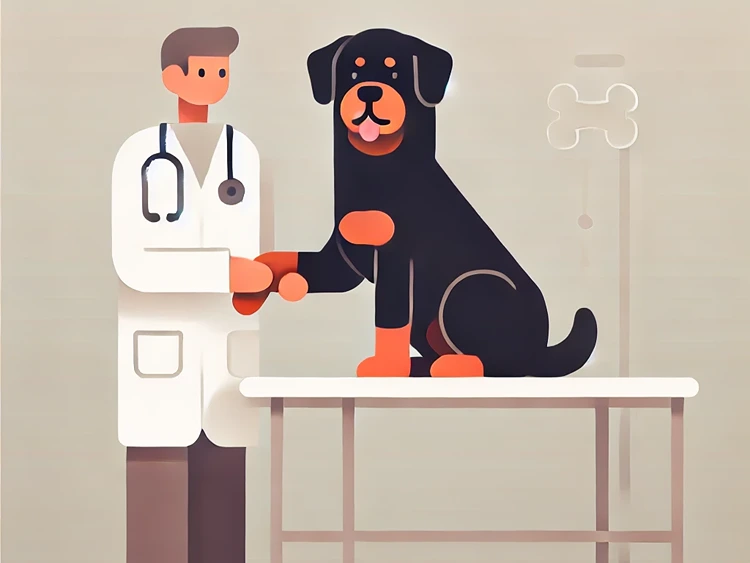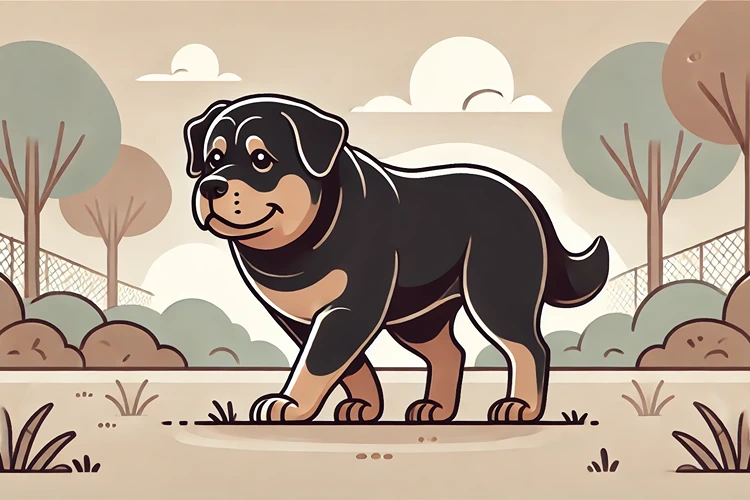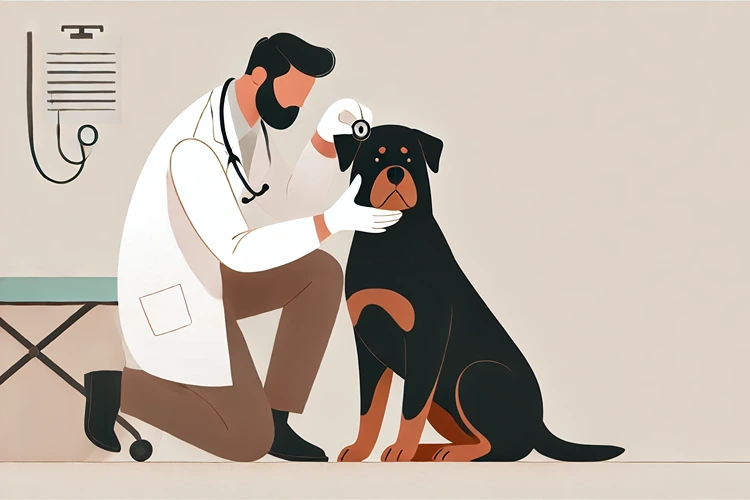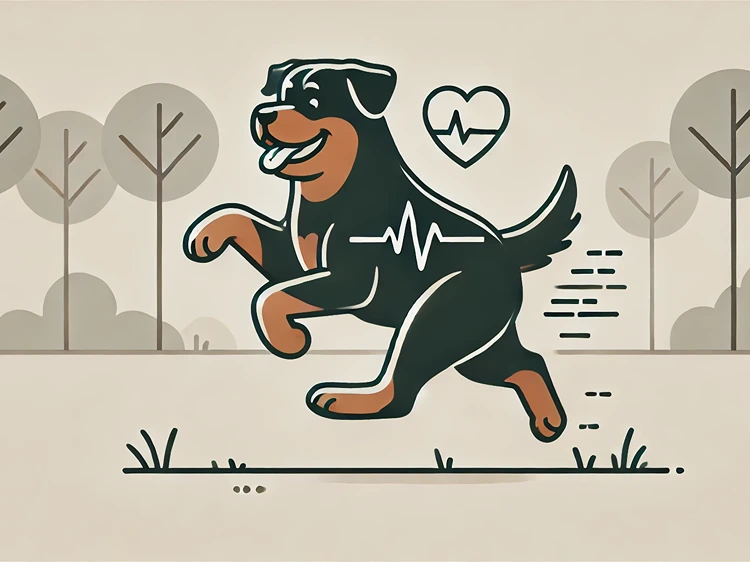Hip dysplasia is a common concern among Rottweiler owners. This condition can severely impact your dog’s quality of life if not managed properly. Simply put, hip dysplasia occurs when the hip joint doesn’t develop correctly, leading to instability and eventual arthritis. Given that Rottweilers are a large and muscular breed, they are particularly prone to this condition. But don’t worry, with the right knowledge and proactive care, you can help prevent or manage hip dysplasia in your Rottie.
What Causes Hip Dysplasia in Rottweilers?
Hip dysplasia in Rottweilers can be influenced by various factors, including genetics, diet, exercise, and overall weight. Let’s break these down:
Genetics: Is Your Rottweiler Predisposed?
Genetics play a significant role in whether a Rottweiler will develop hip dysplasia. If a dog’s parents or grandparents had hip dysplasia, there’s a higher chance that the puppy will inherit this condition. This is why it’s crucial to choose a breeder who screens for hip dysplasia and selects dogs with healthy hips for breeding.
Diet: Are You Feeding Your Rottweiler Right?
Diet is another critical factor in preventing hip dysplasia. Feeding your Rottweiler a balanced diet that supports proper growth and maintains an ideal weight can help minimize stress on their joints. Overfeeding, especially during the puppy stage, can lead to rapid growth, which increases the risk of developing hip dysplasia.
Exercise: Striking the Right Balance
Exercise is essential for keeping your Rottweiler healthy, but too much or too little can be harmful. Over-exercising, particularly on hard surfaces or with high-impact activities, can put unnecessary strain on your Rottweiler’s hips. On the flip side, not enough exercise can lead to muscle weakness, which doesn’t support the joints properly. Finding a balanced exercise routine is key.
Weight Management: Keeping Your Rottweiler Lean
Maintaining a healthy weight is crucial for preventing hip dysplasia in Rottweilers. Extra weight puts added stress on your dog’s joints, making them more susceptible to damage. Regular vet check-ups, a proper diet, and appropriate exercise are the best ways to keep your Rottie in shape.
Paw-some Tip:
Consider feeding your Rottweiler a diet rich in omega-3 fatty acids, glucosamine, and chondroitin. These nutrients support joint health and may reduce the risk of hip dysplasia. Always consult with your vet before making significant changes to your dog’s diet.
Recognizing the Symptoms of Hip Dysplasia
Early detection of hip dysplasia can make a world of difference in how effectively you can manage the condition. Here are some signs to watch out for:
- Difficulty standing up or sitting down
- Noticeable stiffness after resting
- Reduced activity or reluctance to move
- Weakness in the hind legs or a swaying gait
- Visible pain when touched around the hip area
- Avoiding stairs or jumping
If you notice any of these symptoms, it’s important to consult your vet as soon as possible. Early intervention can help slow the progression of hip dysplasia and improve your dog’s quality of life.
Diagnosing Hip Dysplasia in Rottweilers
To accurately diagnose hip dysplasia, your vet will likely perform a combination of physical exams and imaging tests such as X-rays. These tests help assess the condition of your dog’s hip joints and determine the best course of treatment. The earlier the diagnosis, the more effective the treatment options will be.
Treatment Options for Hip Dysplasia in Rottweilers
Treating hip dysplasia involves a combination of lifestyle changes, medications, and in severe cases, surgery. The goal is to reduce pain, improve joint function, and enhance your Rottweiler’s overall quality of life. Here’s a breakdown of potential treatment options:
Lifestyle Modifications
Adjusting your Rottweiler’s daily routine can make a significant difference. This might include weight management, controlled exercise routines, and a comfortable, supportive sleeping area. These changes help reduce stress on the joints and slow the progression of hip dysplasia.
Medications and Supplements
Your vet may prescribe anti-inflammatory medications to help manage pain and inflammation associated with hip dysplasia. Additionally, supplements like glucosamine, chondroitin, and omega-3 fatty acids can support joint health and potentially slow down the disease’s progression.
Physical Therapy and Rehabilitation

Physical therapy can be incredibly beneficial for Rottweilers with hip dysplasia. Exercises that strengthen the muscles around the hip joint can provide better support and stability. Hydrotherapy, or swimming, is another great low-impact exercise that helps build muscle without putting stress on the joints.
Rottie Stats:
According to the Orthopedic Foundation for Animals, approximately 20% of Rottweilers are affected by hip dysplasia. Regular screening and preventive measures can significantly reduce this number.
Surgical Options
In severe cases, surgery may be necessary to alleviate pain and restore mobility. There are several surgical options available, depending on the severity of the condition and the age of your Rottweiler. Common procedures include:
- Femoral Head Ostectomy (FHO): This surgery involves removing the femoral head (the ball part of the ball-and-socket joint), which reduces pain. While this doesn’t fully restore hip function, it can significantly improve your dog’s comfort and mobility.
- Total Hip Replacement (THR): This is a more invasive procedure that involves replacing the entire hip joint with an artificial one. THR can provide a long-term solution and restore near-normal joint function.
- Double or Triple Pelvic Osteotomy (DPO/TPO): These procedures involve cutting and rotating the pelvic bones to improve the fit of the hip socket. They are typically performed in younger dogs before the onset of arthritis.
Your vet will help you determine the best course of action based on your Rottweiler’s specific condition.
Preventing Hip Dysplasia in Rottweilers
Prevention is always better than cure, especially when it comes to hip dysplasia in Rottweilers. While you can’t completely eliminate the risk, there are several proactive steps you can take to significantly reduce the chances of your Rottweiler developing this condition. Here’s what you can do:
Choose a Reputable Breeder
The first and most crucial step in preventing hip dysplasia is choosing a reputable breeder. A responsible breeder will screen their breeding dogs for hip dysplasia and only breed those with healthy hip scores. Ask to see the hip scores of both parents before purchasing a puppy. This is your best chance of getting a Rottweiler with healthy joints.
Monitor Growth During Puppyhood
Puppyhood is a critical period for joint development. Ensure that your Rottweiler puppy grows at a healthy rate by providing a balanced diet and avoiding overfeeding. Rapid growth can lead to improper joint development and increase the risk of hip dysplasia. Talk to your vet about the best diet for your puppy to support healthy growth.
Maintain an Ideal Weight
As mentioned earlier, keeping your Rottweiler at a healthy weight is essential for preventing hip dysplasia. Extra weight puts unnecessary strain on the joints, increasing the risk of developing joint issues. Regularly monitor your dog’s weight and adjust their diet and exercise routine as needed to maintain a healthy balance.
Paw-some Tip:
Weigh your Rottweiler regularly and use a body condition score chart to assess their ideal weight. If you can easily feel their ribs but not see them, your dog is likely at a healthy weight. Adjust their diet and exercise accordingly to maintain this balance.
Exercise Wisely
While exercise is vital for your Rottweiler’s overall health, it’s essential to avoid activities that may harm their developing joints. During puppyhood, avoid high-impact exercises like jumping or running on hard surfaces. Instead, opt for low-impact activities such as swimming or controlled leash walks. As your Rottie matures, you can gradually introduce more strenuous activities, but always monitor for signs of discomfort.
Consider Joint Supplements Early
Even if your Rottweiler doesn’t show any signs of hip dysplasia, consider introducing joint supplements early on. Supplements like glucosamine, chondroitin, and omega-3 fatty acids can support joint health and potentially delay the onset of joint issues. Always consult with your vet before adding supplements to your dog’s diet to ensure they are appropriate and beneficial.
Common Ages for Hip Dysplasia Onset in Rottweilers
| Age Range | Risk Level | Recommended Actions |
|---|---|---|
| 6-12 months | Moderate | Monitor growth rate, ensure proper diet, and avoid high-impact exercises. |
| 1-2 years | High | Conduct screening for early signs of hip dysplasia; begin joint supplements if necessary. |
| 2-4 years | High | Continue monitoring; maintain weight and controlled exercise regimen. |
| 4+ years | Variable | Regular vet check-ups and adjust management strategies as needed. |
Living with a Rottweiler with Hip Dysplasia
If your Rottweiler has been diagnosed with hip dysplasia, it’s important to focus on making their life as comfortable as possible. With the right management strategies, your Rottie can still enjoy a good quality of life. Here’s how to care for a Rottweiler living with hip dysplasia:
Create a Comfortable Living Environment
Ensure your Rottweiler has a comfortable place to rest. Provide a soft, supportive bed that reduces pressure on their joints. Consider placing the bed in a quiet area away from stairs or slippery floors, which can be difficult for a dog with hip dysplasia to navigate. Ramps or stairs to help your dog get onto furniture or into vehicles can also make their life easier.
Focus on Low-Impact Exercise
Regular exercise is still important, but it’s crucial to choose low-impact activities that won’t strain your dog’s hips. Swimming is an excellent option, as it allows your dog to move freely without putting stress on their joints. Gentle leash walks on soft surfaces, such as grass, are also beneficial. Avoid high-impact activities like running, jumping, or playing on hard surfaces.
Regular Vet Check-Ups
Regular vet check-ups are essential for managing hip dysplasia. Your vet can monitor the progression of the condition and adjust treatment plans as needed. They may also recommend additional therapies such as acupuncture, laser therapy, or massage, which can help alleviate pain and improve mobility.
Pain Management Strategies
Pain management is a crucial aspect of caring for a Rottweiler with hip dysplasia. Your vet may prescribe anti-inflammatory medications or pain relievers to help manage discomfort. In addition to medication, consider complementary therapies such as physical therapy or massage, which can help reduce pain and improve your dog’s quality of life.
The Role of Nutrition in Managing Hip Dysplasia
Nutrition plays a significant role in managing hip dysplasia. A balanced diet that supports joint health can help reduce inflammation and pain while promoting overall well-being. Here’s how to optimize your Rottweiler’s diet for hip dysplasia:
Incorporate Anti-Inflammatory Foods
Foods rich in omega-3 fatty acids, such as fish oil, can help reduce inflammation in the joints. You can also include other anti-inflammatory foods like turmeric or ginger in your dog’s diet, but be sure to consult with your vet before introducing new supplements or foods.
Consider a Prescription Diet
Some vets may recommend a prescription diet specifically formulated for joint health. These diets often contain added glucosamine, chondroitin, and omega-3 fatty acids to support joint function. While they may be more expensive, these diets can be beneficial for dogs with hip dysplasia.
Maintain a Healthy Weight
As always, maintaining a healthy weight is crucial. Feeding your Rottweiler the right amount of high-quality food and avoiding overfeeding can help keep their weight in check. Consider feeding smaller, more frequent meals to manage their weight better and keep their energy levels stable.
FAQs
Wrapping Up
Rottweiler joint health is a critical aspect of ensuring your dog lives a long, active, and pain-free life. Understanding the risks and signs of hip dysplasia, along with proactive measures like proper diet, controlled exercise, and regular vet visits, can go a long way in preventing or managing this condition. By taking early action and staying informed, you can protect your Rottweiler from the pain and discomfort associated with hip dysplasia, allowing them to enjoy a vibrant and happy life. Remember, your vigilance and care are key to maintaining your Rottweiler’s joint health.
For more tips and advice on keeping your Rottweiler healthy, be sure to explore other resources on our website. Stay proactive, stay informed, and continue to prioritize your Rottweiler’s well-being.




